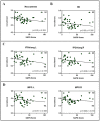Frequency-Specific Analysis of the Dynamic Reconfiguration of the Brain in Patients with Schizophrenia
- PMID: 35741612
- PMCID: PMC9221032
- DOI: 10.3390/brainsci12060727
Frequency-Specific Analysis of the Dynamic Reconfiguration of the Brain in Patients with Schizophrenia
Abstract
The analysis of resting-state fMRI signals usually focuses on the low-frequency range/band (0.01−0.1 Hz), which does not cover all aspects of brain activity. Studies have shown that distinct frequency bands can capture unique fluctuations in brain activity, with high-frequency signals (>0.1 Hz) providing valuable information for the diagnosis of schizophrenia. We hypothesized that it is meaningful to study the dynamic reconfiguration of schizophrenia through different frequencies. Therefore, this study used resting-state functional magnetic resonance (RS-fMRI) data from 42 schizophrenia and 40 normal controls to investigate dynamic network reconfiguration in multiple frequency bands (0.01−0.25 Hz, 0.01−0.027 Hz, 0.027−0.073 Hz, 0.073−0.198 Hz, 0.198−0.25 Hz). Based on the time-varying dynamic network constructed for each frequency band, we compared the dynamic reconfiguration of schizophrenia and normal controls by calculating the recruitment and integration. The experimental results showed that the differences between schizophrenia and normal controls are observed in the full frequency, which is more significant in slow3. In addition, as visual network, attention network, and default mode network differ a lot from each other, they can show a high degree of connectivity, which indicates that the functional network of schizophrenia is affected by the abnormal brain state in these areas. These shreds of evidence provide a new perspective and promote the current understanding of the characteristics of dynamic brain networks in schizophrenia.
Keywords: dynamic reconfiguration; frequency-specific; multilayer network.
Conflict of interest statement
The authors declare no conflict of interest.
Figures







Similar articles
-
Abnormal dynamic reconfiguration of the large-scale functional network in schizophrenia during the episodic memory task.Cereb Cortex. 2023 Mar 21;33(7):4135-4144. doi: 10.1093/cercor/bhac331. Cereb Cortex. 2023. PMID: 36030383
-
Multiple functional connectivity networks fusion for schizophrenia diagnosis.Med Biol Eng Comput. 2020 Aug;58(8):1779-1790. doi: 10.1007/s11517-020-02193-x. Epub 2020 Jun 3. Med Biol Eng Comput. 2020. PMID: 32495268
-
A joint time-frequency analysis of resting-state functional connectivity reveals novel patterns of connectivity shared between or unique to schizophrenia patients and healthy controls.Neuroimage Clin. 2017 Jun 17;15:761-768. doi: 10.1016/j.nicl.2017.06.023. eCollection 2017. Neuroimage Clin. 2017. PMID: 28706851 Free PMC article.
-
Dynamic Functional Connectivity Strength Within Different Frequency-Band in Schizophrenia.Front Psychiatry. 2020 Feb 12;10:995. doi: 10.3389/fpsyt.2019.00995. eCollection 2019. Front Psychiatry. 2020. PMID: 32116820 Free PMC article.
-
Abnormal Dynamic Reconfiguration of Multilayer Temporal Networks in Patients with Bipolar Disorder.Brain Sci. 2024 Sep 19;14(9):935. doi: 10.3390/brainsci14090935. Brain Sci. 2024. PMID: 39335429 Free PMC article.
Cited by
-
Abnormal Dynamic Reconstruction of Overlapping Communities in Schizophrenia Patients.Brain Sci. 2024 Aug 1;14(8):783. doi: 10.3390/brainsci14080783. Brain Sci. 2024. PMID: 39199476 Free PMC article.
-
Dynamic multilayer functional connectivity detects preclinical and clinical Alzheimer's disease.Cereb Cortex. 2024 Jan 31;34(2):bhad542. doi: 10.1093/cercor/bhad542. Cereb Cortex. 2024. PMID: 38212285 Free PMC article.
References
-
- Zou H., Yang J.J. Multi-frequency Dynamic Weighted Functional Connectivity Networks for Schizophrenia Diagnosis. Appl. Magn. Reson. 2019;50:847–859. doi: 10.1007/s00723-019-01117-9. - DOI
LinkOut - more resources
Full Text Sources

